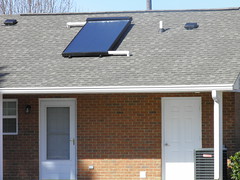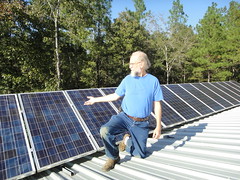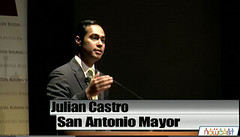
Federal 30% and Georgia 35% rebates add up to 65% (see below under DSIRE). That’s for solar (PV or hot water), wind, and some other related items.
The other 35% is what stops most businesses and people. 35% of a $25,000 house solar system is still $8,750. People like that it will pay itself off in 9-15 years, but most people don’t have $8,750 to invest.
That’s a business opportunity for some enterprising local bank or banks. As Dr. Noll has explained, if you pay for that remainder yourself, the system will pay itself off in about 9 years. If you get a bank to finance it, more like 15 years. And local banks currently require collateral other than the system itself (they like real estate as collateral). The simplest business opportunity is for a local bank to accept the solar equipment itself as collateral. After all, it’s worth 65/35 or 185% of the total loan amount.
 The
Georgia Solar Energy Association (GSEA)
can probably tell you more.
The
Georgia Solar Energy Association (GSEA)
can probably tell you more.
Other ways to finance renewable energy projects include:
- Solar Mosaic, in which individuals buy shares in a solar installation.
- SolarCity, which does everything from financing to installation.
Private Venture Capital
There is private venture capital looking for solar and renewable energy projects.- Google invested $280 million in SolarCity in June 2011
- National Solar Power is installing a 400 MW $1.5 billion solar project in Gadsden County, Florida, using private funding.
- MP2 Capital of San Francisco wants 1-5 MW projects
- PowerFin of Austin is looking for 2 MW (300,000 sq ft or 6.8 acres) and up
DSIRE: Database of State Incentives for Renewables & Efficiency.
DSIRE for federal
First, before people start griping about subsidies, remember fossil fuel gets many times the subsidies of renewable energy,
and if solar got the same subsidies it would be cheaper than
current grid power everywhere in the U.S.
fossil fuel gets many times the subsidies of renewable energy,
and if solar got the same subsidies it would be cheaper than
current grid power everywhere in the U.S.
For that matter, if Georgia Power’s Construction Work in Progress (CWIP) addon to their customer’s bills for the two new Plant Vogtle nuclear reactors was applied to solar instead, Georgia Power would be installing a lot of solar!
If you want to argue that nothing should get subsidies, point noted, I don’t agree, and feel free to write your own blog post.
Here’s the DSIRE Federal webpage.
The big one is the 30% Business Energy Investment Tax Credit (ITC)
There is a matching 30% Residential Renewable Energy Tax Credit
Others range
- from energy-efficient commercial buildings tax deduction of $0.30 to $1.80 / sq ft
- to accelerated depreciation (100% bonus deprec. for 2010 and 50% for 2012),
- to a home builder tax credit for new homes of $1,000 to $2,000.
HUD “strongly encourages Public Housing Agencies (PHAs) to use solar, wind, geothermal/ground coupled heat pumps and other renewable energy sources, and other ‘green’ construction and rehabilitation techniques whenever they procure for maintenance, construction, or modernization.”Those could help with jobs in Valdosta among the communities most in need of employment.
That HUD web page has links to many national, regional, and state green building programs for new construction and building rehabilitation.
 Kevin Skeath installed solar electricity and hot water last year
in a public housing project near Quitman.
I don’t know how it was funded, but the builder is in Valdosta.
Kevin Skeath installed solar electricity and hot water last year
in a public housing project near Quitman.
I don’t know how it was funded, but the builder is in Valdosta.
South GA Solar Power can also do local installations.
The
USDA REAP grants
 (like
the one I just got)
are all allocated for this year, and it’s not
clear what Congress is going to do about them next year. I hear
at the least they’re changing them from grants to rebates, and they
may not fund them at all.
(like
the one I just got)
are all allocated for this year, and it’s not
clear what Congress is going to do about them next year. I hear
at the least they’re changing them from grants to rebates, and they
may not fund them at all.
DSIRE for Georgia
Here is DSIRE’s web page for Georgia.
Also a 35% personal clean energy tax credit (GEFA).
Both the corporate and personal tax credits are under the same program:
“As part of the Georgia Energy Challenge, Georgia offers tax credits for certain types of energy efficienct and renewable energy property as well as for the delivery of wood residuals to qualified biomass facilities. The credits will be available to taxpayers placing qualified clean energy property in service between July 1, 2008, and December 31, 2014. The program’s annual cap is $2.5 million for 2008 through 2011 and $5 million for 2012 through 2014.”This is the program that was renewed this summer, with the doubled amount ($2.5M became $5M).
I hear all the funds for 2011 are already allocated, and most of those for 2012, but it’s possible to get in the queue for 2013 funds and get them in 2013.
Also visible under the above DSIRE Georgia link are these items:
- Several EMCs in the state have utility loan or rebate programs. Maybe the Chamber could help convince Colquitt EMC to do the same.
- Several Georgia cities have local loan or rebate programs, or energy standards for public buildings. Maybe the Chamber could help convince Valdosta or Hahira or Lake Park or Remerton or Dasher to do some of that.
 San Antonio is getting ahead of Austin on sustainable energy and jobs:
San Antonio is getting ahead of Austin on sustainable energy and jobs:
North Carolina’s experience indicates a key is getting local projects widely distributed so everybody can see it working in their own back yard:
Valdosta already has that with the Wiregrass Solar plant, and Lowndes County has it with three house-scale solar installations.
Speaking of Wiregrass Solar, Sterling Planet would like to expand that array, and Hannah Solar has all the solar incentive paperwork ready to go.
So, basically anyone can get 65% off the installation of a moderate-sized solar array. For the remaining 35%, there are some solutions such as Solar Mosaic and SolarCity, and a business opportunity for local banks. Systems from 1-5 megawatts might attract venture capital financing. Plus there are many special cases, for example for public housing.
-jsq
Short Link: